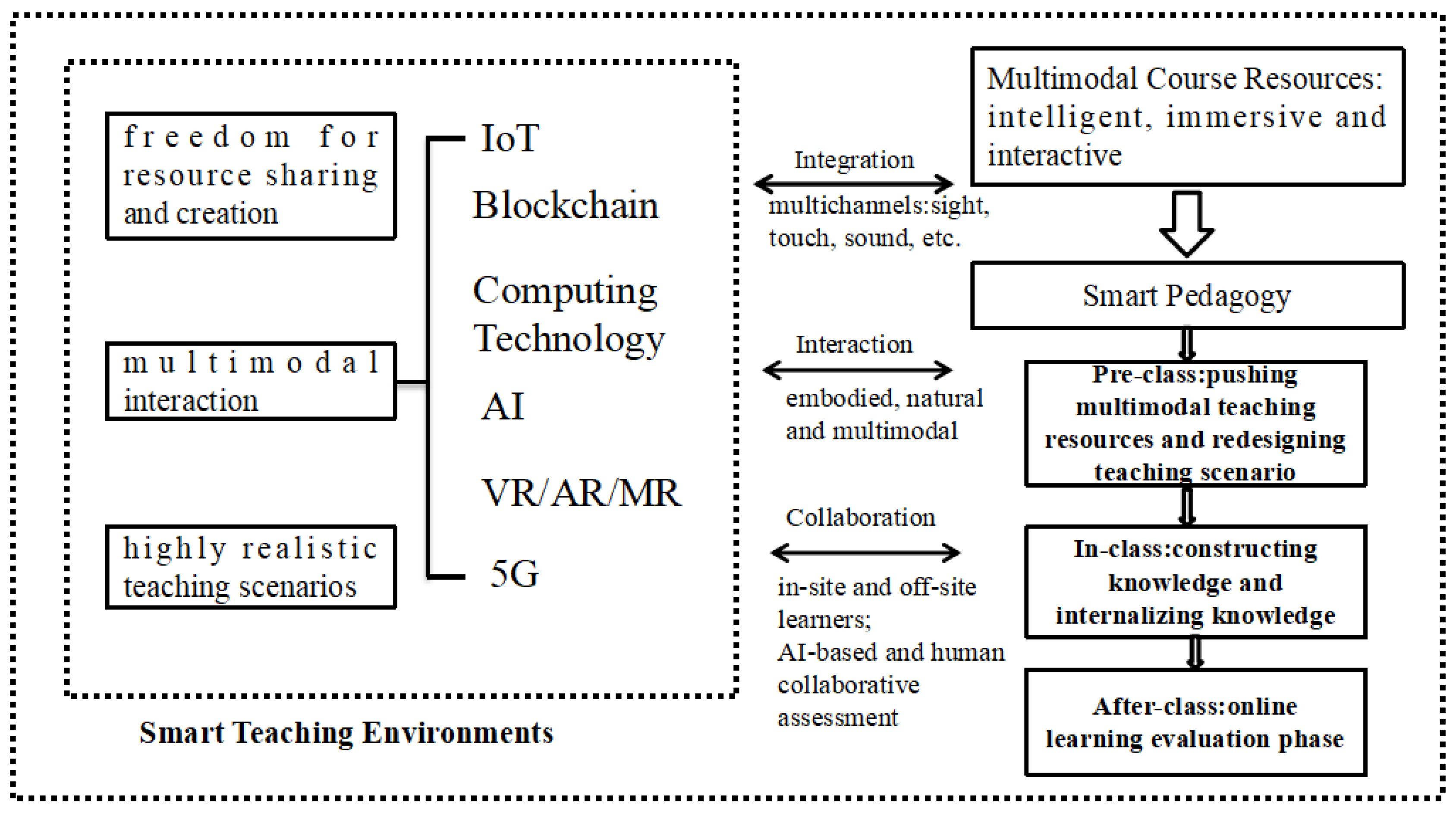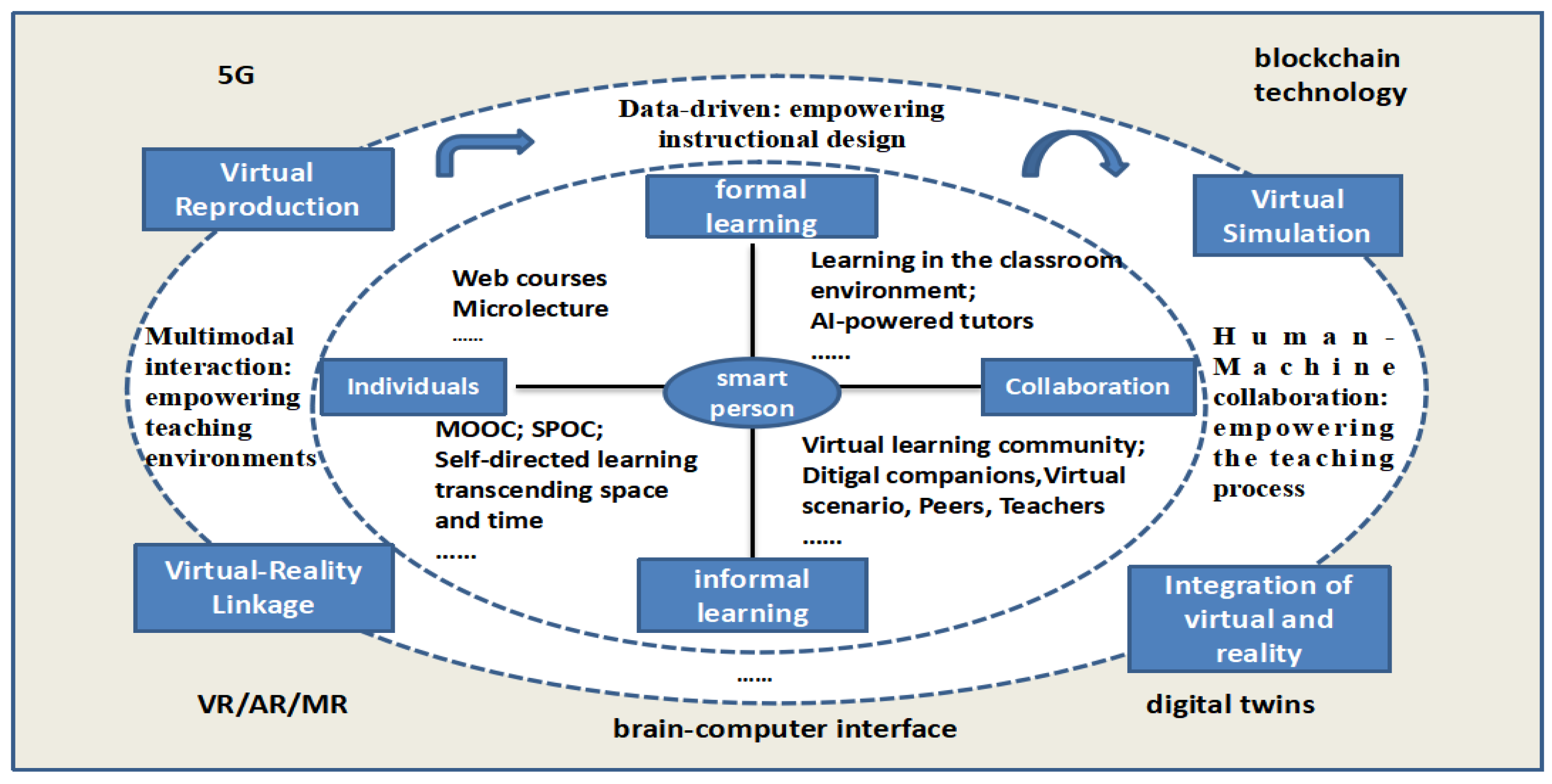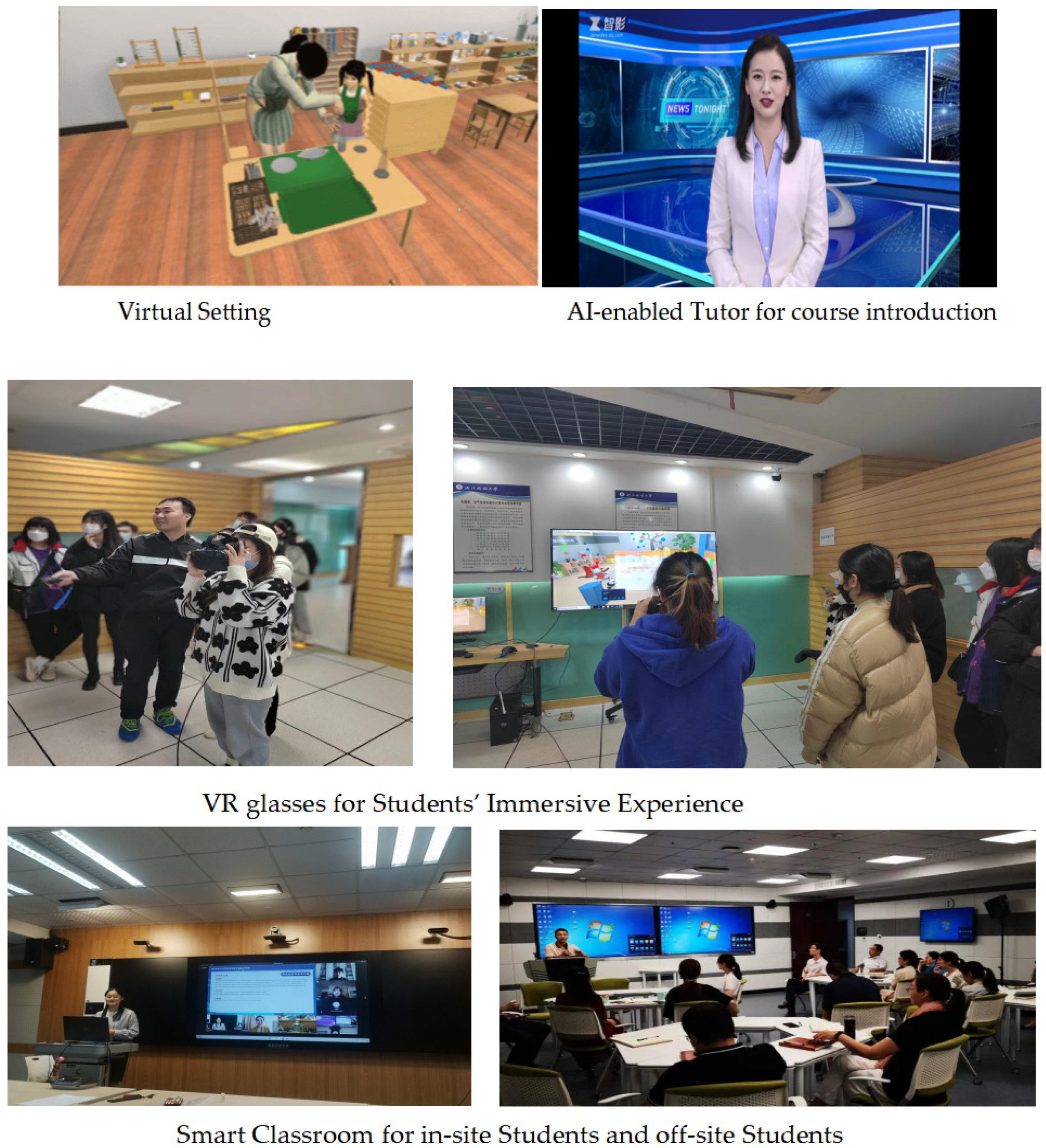An Empirical Study of A Smart Education Model Enabled by the Edu-Metaverse to Enhance Better Learning Outcomes for Students
Abstract
:1. Introduction
2. Potential of the Edu-Metaverse in the Reconstruction of a Smart Education Model
2.1. Current Status of the Edu-Metaverse
2.2. Current Status of Smart Education
2.3. The Use of the Edu-Metaverse in Smart Education
3. The Architecture and Realization of a Smart Education Model Enabled by the Edu-Metaverse
3.1. Theoretical Framework
3.2. Realization of a Smart Education Model in the Edu-Metaverse
3.2.1. The Construction of Smart Teaching Environments
3.2.2. Multimodal Course Resources
3.2.3. Smart Pedagogy in the Context of the Edu-Metaverse
4. Methodology
4.1. Participants
4.2. Research Instruments
4.3. Study Process
4.3.1. Pre-Class: Pushing Multimodal Teaching Resources and Redesigning Teaching Scenario
4.3.2. In-Class: Online Student–Teacher Interaction Phase
4.3.3. After-Class: Online Learning Evaluation Phase
5. Results
5.1. Results of Post-Test
5.2. Results of Questionnaires and Interviews
6. Discussion
6.1. Improve the Design of Teaching Scenarios and Pave the Way for New Knowledge
6.2. Focus on Learning Assessment, Based on Core Competency, from the Perspective of the Edu-Metaverse
6.3. Enhance and Improve Teachers’ Knowledge Architecture in the Edu-Metaverse
7. Conclusions
Author Contributions
Funding
Institutional Review Board Statement
Informed Consent Statement
Data Availability Statement
Conflicts of Interest
Appendix A
References
- Zhiting, Z.; Hongwei, L.; Chengqian, W.; Jiao, H. Digital Transformation and Integrative Innovations of Foreign Language Education. Technol. Enhanc. Foreign Lang. 2022, 4, 7. [Google Scholar]
- Bokyung, K.; Nara, H.; Eunji, K.; Yeonjeong, P.; Soyoung, J. Educational applications of metaverse:possibilities and limitations. J. Educ. Eval. Health Prof. 2021, 18, 32. [Google Scholar]
- Stephenson, N. Snow Crash; Bantam Books: New York, NY, USA, 1992; p. 63. [Google Scholar]
- Geping, L.; Nan, G.; Hanling, H.; Yuchao, Q. Edu-Metaverse: Characteristic, mechanism and application scenarios. Open Educ. Res. 2022, 1, 24–33. [Google Scholar]
- Su, C.; Xinyue, J.; Bojun, S. Open another gate to education—Application, challenge and prospect of educational metaverse. Mod. Educ. Technol. 2022, 1, 16–26. [Google Scholar]
- Jin, Z.; Junmin, Y.; Chao, L. Multimodal learning affective computing: Motivations, frameworks and suggestions. e-Educ. Res. 2021, 7, 26–32. [Google Scholar]
- Zhiming, Y.; Xiaxia, T.; Xuan, Q.; Fei, Z.; Yuanmei, D. The connotations, key technologies and application trends of educational artificial intelligence (EAI): Interpretation and analysis of the two reports entitled “preparing for the future of artificial intelligence” and “the national artificial intelligence research and development strategic plan”. J. Distance Educ. 2017, 1, 26–35. [Google Scholar]
- Zhiting, Z.; Fei, W. Innovative paths of teacher development for smart education. J. Chin. Soc. Educ. 2017, 9, 21–28. [Google Scholar]
- Makarova, E. Effectiveness of traditional and online learning: Comparative analysis from the student perspective. In SHS Web of Conferences; EDP Sciences: Les Ulis, France, 2021. [Google Scholar]
- Marketing. Top 6 Advantages of Traditional Education. Available online: https://potomac.edu/top-advantages-of-traditional-education/ (accessed on 20 January 2022).
- Yuemeng, W. A comparative study on the effectiveness of traditional and modern teaching methods. In 2022 5th International Conference on Humanities Education and Social Sciences (ICHESS 2022); Atlantis Press: Paris, France, 2022; pp. 270–277. [Google Scholar]
- Yuefan, Y.; Xiaoyun, Z.; Xianmin, Y. Construction of online-offline(OMO) learning space and design of teaching mode based on metaverse. J. Distance Educ. 2022, 4, 14–22. [Google Scholar]
- Barry, D.M.; Kanematsu, H.; Fukumura, Y.; Ogawa, N.; Okuda, A.; Taguchi, R.; Nagai, H. International Comparison for Problem Based Learning in Metaverse. The ICEE and ICEER. 2019; p. 6066. Available online: https://www.ineer.org/Events/ICEEiCEER2009/full_papers/full_paper_145.pdf (accessed on 16 March 2021).
- Wenxiao, F.; Wenlong, Z.; Haiduo, H. An empirical study of the effectiveness of embodied learning in the edu-metaverse field. Open Educ. Res. 2022, 2, 85–95. [Google Scholar]
- Yawen, W.; Li, Y.; Changyuan, W.; Guohui, W. Discussion on experimental teaching in educational metaverse. Res. High. Educ. Eng. 2022, 4, 96–101. [Google Scholar]
- Hongyu, L. Exploration and prospect of physical education model based on metaverse. High. Educ. Explor. 2022, 1, 75–79. [Google Scholar]
- Ronghuai, H. Three realms of smart education: Smart learning environment, ICT teaching model and modern educational system. Mod. Distance Educ. Res. 2014, 6, 3–11. [Google Scholar]
- Shaochun, Z.; Zhuo, Z.; Zhuo, Z. How to construct smart classroom. e-Educ. Res. 2020, 10, 15–21. [Google Scholar]
- Xin, Y.; Yueguang, X. A picture of classroom transformation in intelligent era: Smart classroom and its construction strategies. e-Educ. Res. 2021, 4, 12–17. [Google Scholar]
- Jijian, L.; Meimei, Z.; Xia, Z.; Wanqing, H.; Mingmin, Z. Exploration of “multi-mode+human-machine collaboration” teaching and application based on MR experiment. J. Distance Educ. 2021, 6, 58–66. [Google Scholar]
- Xiaochun, Z. A preliminary study of the smart learning model in foreign language acquisition: A multimodal perspective. J. Hubei Univ. Arts Sci. 2020, 4, 72–76. [Google Scholar]
- Su, C.; Xinyue, J.; Yang, Y.; Linfan, J.; Shengquan, Y. Practice of multimodality smart classroom under 5G environment. Mod. Distance Educ. Res. 2021, 5, 105–112. [Google Scholar]
- Xiaoqing, G.; Hua, D.; Hongchao, P.; Zhiting, Z. The theoretical framework, development and future prospect of smart education. J. East China Norm. Univ. 2021, 8, 20–32. [Google Scholar]
- Huijun, W.; Haili, W. A study of flipped classroom teaching model in multimodal perspective. e-Educ. Res. 2015, 12, 70–76. [Google Scholar]
- Dinnision, J.D.N.; Burns, W.; Gilbert, R. 3D virtual worlds and the metaverse: Current status and future possibilities. ACM Comput. Surv. 2013, 2, 1–38. [Google Scholar] [CrossRef]
- Geping, L.; Xing, W.; Nan, G.; Hanlin, H. From virtual reality to metaverse: A new direction of online education. Mod. Distance Educ. Res. 2022, 4, 47–54. [Google Scholar]
- Akcayir, M.; Akcayir, G. Advantages and Challenges Associated with Augmented Reality Crossmark for Education: A Systematic Review of the Literature. Educ. Res. Rev. 2017, 20, 1–11. [Google Scholar] [CrossRef]
- Mystakidis, S. The Metaverse in Education. 2022. Available online: http://oeb.global/oeb-insights/the-metaverse-in-edcation/ (accessed on 15 February 2022).
- Sen, Z.; Hongjun, Y. Edu-metaverse: Current focus, potential themes and future directions. Educ. Res. Mon. 2022, 6, 3–11. [Google Scholar]
- Almirall, E. Teaching in the Metaverse Is Much Closer to Being in the Classroom Than in an Online Session. 2022. Available online: https://dobetter.esade.edu/en/technology-virtual-reality-education (accessed on 10 May 2022).
- Wenchao, Z.; Lei, Y.; Ruonan, Y.; Hang, Y. Gamification learning to learning metaverse: New framework and practical essentials for immersive learning. J. Distance Educ. 2022, 4, 3–13. [Google Scholar]
- Xing, W.; Geping, L.; Liqiao, N.; Nan, G.; Qiyu, Z.; Yuhan, G. Cultivation mechanism enabling students’ wisdom in smart classroom: Internal mechanism, structural elements and connection paths. e-Educ. Res. 2021, 8, 26–34. [Google Scholar]
- Csikszentmihalyi, M.; Kolo, C.; Baur, T. Flow: The psychology of optimal experience. Aust. Occup. Ther. J. 2004, 51, 3–12. [Google Scholar]
- Varela, F.; Thompson, E.; Rosch, E. The Embodied Mind: Cognitive Science and Human Experience; The MIT Press: Cambridge, MA, USA, 1992. [Google Scholar]
- Rospigliosi, P.A. Metaverse or simulacra? Roblox, minecraft, meta and the turn to virtual reality for education, socialisation and work. Interact. Learn. Environ. 2022, 1, 1–3. [Google Scholar] [CrossRef]
- Hua, D.; Xiaoqing, G. Knowledge prospect in the era of intelligence: Knowledge view reshaped by artificial intelligence. Mod. Distance Educ. Res. 2022, 4, 47–54. [Google Scholar]
- Hongchao, P.; Zhiting, Z. Generative design of precision instruction activities in smart learning context. e-Educ. Res. 2016, 8, 53–62. [Google Scholar]
- Venkatesh, V.; Bala, H. Technology acceptance model 3 and a research agenda on interventions. Decis. Sci. 2008, 39, 273–315. [Google Scholar] [CrossRef]
- Dhimolea, T.K.; Kaplan-Rakowski, R.; Lin, L. A systematic review of research on high-immersion virtual reality for language learning. TechTrends 2022, 66, 810–824. [Google Scholar] [CrossRef]
- Parmaxi, A. Virtual reality in language learning: A systematic review and implications for research and practice. Interact. Learn. Environ. 2020, 5, 1–13. [Google Scholar] [CrossRef]
- Zixun, H.; Muxiong, H. The teaching field structure, key technologies and experimental study of edu-metaverse. Mod. Distance Educ. Res. 2021, 6, 23–31. [Google Scholar]
- Liang, L.; Zhiting, Z. Metaverse for education: Practical value and development objectives. Chin. J. Distance Educ. 2022, 6, 1–10. [Google Scholar]
- Angxuan, C.; Jiyou, J. Educational metaverse: New modality of teaching and learning with virtual immersion. Res. Teach. 2022, 5, 1–6. [Google Scholar]
- Libao, W.; Yanan, C.; Yiming, C. Reform and practical paths of classroom teaching evaluation under artificial intelligence. China Educ. Technol. 2021, 5, 94–101. [Google Scholar]
- Huaibo, W.; Huanyou, C.; Liming, G.; Zijing, L.; Qinhua, Z. Evaluation of students’ comprehensive literacy supported by intelligent technology: Framework design and implementation path. China Educ. Technol. 2022, 8, 16–23. [Google Scholar]
- Kaiquan, C.; Chunxun, Z.; Yueyue, W.; Lu, L. Multi-modal learning analysis, adaptive feedback and human-computer coordination of artificial intelligence in education (EAI). J. Distance Educ. 2019, 5, 24–34. [Google Scholar]
- Xiaoyang, S. Exploration and practice of progressive translation workshop model based on workplace learning theory in the AI era. Technol. Enhanc. Foreign Lang. 2021, 2, 65–72. [Google Scholar]
- Jian, X.; Jun, W.; Zheng, Z.; Guoliang, Z.; Sijia, F. Challenges and measures of faculty development in the era of educational metaverse. Open Educ. Res. 2022, 3, 51–56. [Google Scholar]
- Ruyi, L.; Junfeng, Y.; Feng, J.; Jiaping, L. Does teachers’ data literacy and digital teaching competence influence empowering students in the classroom? Evidence from China. Educ. Inf. Technol. 2022, 9, 1–23. [Google Scholar]




| Effect | Value | F | Hypothesis df | Error df | Sig. | |
|---|---|---|---|---|---|---|
| Intercept | Pillai’s Trace | 0.995 | 1763.860 b | 6.000 | 53.000 | 0.000 |
| Wilks’ Lambda | 0.005 | 1763.860 b | 6.000 | 53.000 | 0.000 | |
| Hotelling’s Trace | 199.682 | 1763.860 b | 6.000 | 53.000 | 0.000 | |
| Roy’s Largest Root | 199.682 | 1763.860 b | 6.000 | 53.000 | 0.000 | |
| Groups | Pillai’s Trace | 0.769 | 29.477 b | 6.000 | 53.000 | 0.000 |
| Wilks’ Lambda | 0.231 | 29.477 b | 6.000 | 53.000 | 0.000 | |
| Hotelling’s Trace | 3.337 | 29.477 b | 6.000 | 53.000 | 0.000 | |
| Roy’s Largest Root | 3.337 | 29.477 b | 6.000 | 53.000 | 0.000 | |
| Source | Dependent Variable | Type III Sum of Squares | df | Mean Square | F | Sig. |
|---|---|---|---|---|---|---|
| Group | Reading | 212.817 | 1 | 212.817 | 146.887 | 0.000 |
| Role Play | 43.350 | 1 | 43.350 | 60.392 | 0.000 | |
| Translation | 64.067 | 1 | 64.067 | 98.130 | 0.000 | |
| Vocabulary and Grammar | 114.817 | 1 | 114.817 | 88.989 | 0.000 | |
| Reading Comprehension | 129.067 | 1 | 129.067 | 57.290 | 0.000 | |
| Writing | 166.667 | 1 | 166.667 | 133.641 | 0.000 | |
| Overall Results | 4116.817 | 1 | 4116.817 | 150.612 | 0.000 |
Disclaimer/Publisher’s Note: The statements, opinions and data contained in all publications are solely those of the individual author(s) and contributor(s) and not of MDPI and/or the editor(s). MDPI and/or the editor(s) disclaim responsibility for any injury to people or property resulting from any ideas, methods, instructions or products referred to in the content. |
© 2023 by the authors. Licensee MDPI, Basel, Switzerland. This article is an open access article distributed under the terms and conditions of the Creative Commons Attribution (CC BY) license (https://creativecommons.org/licenses/by/4.0/).
Share and Cite
Shu, X.; Gu, X. An Empirical Study of A Smart Education Model Enabled by the Edu-Metaverse to Enhance Better Learning Outcomes for Students. Systems 2023, 11, 75. https://doi.org/10.3390/systems11020075
Shu X, Gu X. An Empirical Study of A Smart Education Model Enabled by the Edu-Metaverse to Enhance Better Learning Outcomes for Students. Systems. 2023; 11(2):75. https://doi.org/10.3390/systems11020075
Chicago/Turabian StyleShu, Xiaoyang, and Xiaoqing Gu. 2023. "An Empirical Study of A Smart Education Model Enabled by the Edu-Metaverse to Enhance Better Learning Outcomes for Students" Systems 11, no. 2: 75. https://doi.org/10.3390/systems11020075





